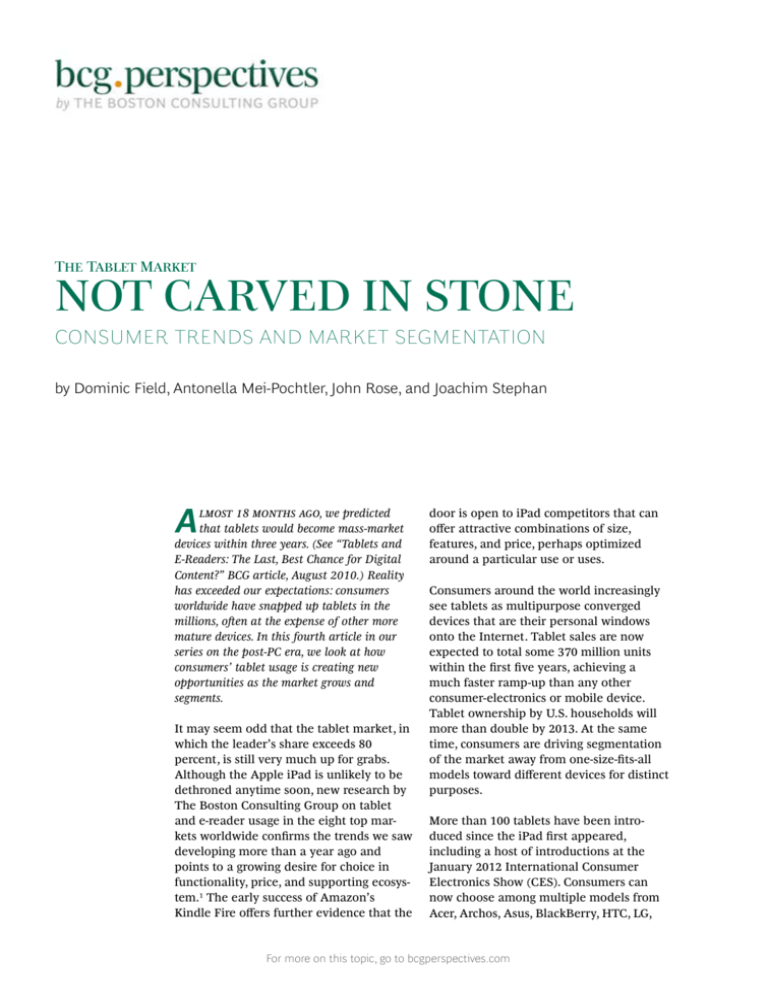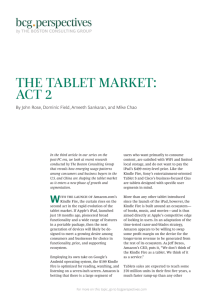
The Tablet Market
Not Carved in Stone
Consumer Trends and Market Segmentation
by Dominic Field, Antonella Mei-Pochtler, John Rose, and Joachim Stephan
A
lmost 18 months ago, we predicted
that tablets would become mass-market
devices within three years. (See “Tablets and
E-Readers: The Last, Best Chance for Digital
Content?” BCG article, August 2010.) Reality
has exceeded our expectations: consumers
worldwide have snapped up tablets in the
millions, often at the expense of other more
mature devices. In this fourth article in our
series on the post-PC era, we look at how
consumers’ tablet usage is creating new
opportunities as the market grows and
segments.
It may seem odd that the tablet market, in
which the leader’s share exceeds 80
percent, is still very much up for grabs.
Although the Apple iPad is unlikely to be
dethroned anytime soon, new research by
The Boston Consulting Group on tablet
and e-reader usage in the eight top markets worldwide confirms the trends we saw
developing more than a year ago and
points to a growing desire for choice in
functionality, price, and supporting ecosystem.1 The early success of Amazon’s
Kindle Fire offers further evidence that the
door is open to iPad competitors that can
offer attractive combinations of size,
features, and price, perhaps optimized
around a particular use or uses.
Consumers around the world increasingly
see tablets as multipurpose converged
devices that are their personal windows
onto the Internet. Tablet sales are now
expected to total some 370 million units
within the first five years, achieving a
much faster ramp-up than any other
consumer-electronics or mobile device.
Tablet ownership by U.S. households will
more than double by 2013. At the same
time, consumers are driving segmentation
of the market away from one-size-fits-all
models toward different devices for distinct
purposes.
More than 100 tablets have been introduced since the iPad first appeared,
including a host of introductions at the
January 2012 International Consumer
Electronics Show (CES). Consumers can
now choose among multiple models from
Acer, Archos, Asus, BlackBerry, HTC, LG,
For more on this topic, go to bcgperspectives.com
Lenovo, Motorola, Samsung, Sony, and
Toshiba (as well as Apple, of course), to
name a few. Tablets are taking sales from
other devices—most notably netbooks and
portable media players such as iPods but
also notebooks and PCs.
Ownership
Ownership is on the rise around the world,
as is intent to purchase. In the U.S., a
stunning 30 percent of respondents say
that they already own a tablet or an
e-reader, almost double the 16 percent of a
year ago. Although levels of ownership are
lower in other countries, the rate of
increase is even higher—nearly a fourfold
rise in the U.K., for example, to 27 percent,
and a tripling in both France and Spain.
Familiarity with tablets and e-readers is
high. In most countries, two-thirds or more
of consumers either own devices or are
familiar with them, representing doubledigit percentage increases since 2010. Half
of nonowners in the U.S. say that they
intend to buy a tablet or an e-reader in the
next year. Purchase intent is even higher
elsewhere, with every country surveyed
showing double-digit increases, save Japan,
which lags in tablet ownership. And in
China, among Internet users in major
cities, intent tops 70 percent. Actual sales
always trail statements of intent, but it is
clear that the tablet wave around the
world continues to build.
Tablets are taking—and will continue to
attract—share from other devices. Netbooks and portable media devices such as
the iPod will feel the biggest losses, but
PCs and notebooks are not immune.
Approximately half of consumers interested in purchasing a device in the next 12
months are looking at a tablet rather than
a netbook. (See Exhibit 1.) One-third are
considering a tablet over a home PC or laptop. Similarly, substantial shares of tablet
owners—between one-third and onehalf—think it is likely that their tablets will
replace their PCs, laptops, netbooks, and
portable media devices. One-third of
consumers are considering purchase of an
Exhibit 1 | Consumers Substitute Tablets or E-Readers for Current Devices
Strongly or somewhat likely (%)
Potential buyers
interested in
purchasing an
e-reader instead
of a . . .
50
0
34
33
Netbook
33
32
21
21
Portable
media device
21
Laptop or
notebook
21
20
Home PC
22
18
Smartphone
18
TV
Strongly or somewhat likely (%)
Potential buyers
interested in
purchasing a
tablet instead of
a...
100
50
0
53
53
Netbook
52
56
E-reader
45
43
35
Portable
media device
36
Laptop or
notebook
34
31
Home PC
27
29
Smartphone
20
20
TV
Strongly or somewhat likely (%)
Tablet owners
indicating their
tablet will replace
their . . .
50
0
38
41
Home PC
U.S.
38
49
Laptop or
notebook
35
41
Netbook
29
37
Portable
media device
27
36
E-reader
14
21
TV
13
20
Smartphone
Worldwide median
Sources: BCG e-reader survey (n = 8,700), November 2011; BCG analysis.
| Not Carved in Stone
2
e-reader instead of a netbook or portable
media device. One in five is also thinking
about choosing an e-reader over a PC,
laptop, or smartphone.
Convergence and Segmentation
Many consumers are planning to do more
with their tablets—read, watch, listen, surf,
e-mail—and they are gravitating toward
devices with convergent capabilities. At the
same time, interest in expanded capabilities for single-purpose e-readers remains
strong. Consumers like choice, and as the
tablet cements its position as a personal
entertainment and communications center,
they see value in both multipurpose tablets
and optimized single-function devices.
Consumers are assigning value to the differing device capabilities through price.
Sixty-eight percent of U.S. consumers say
that they prefer a multipurpose tablet such
as the iPad, Android-driven Samsung
Galaxy Tab, or Amazon-based Kindle Fire
to a single-purpose e-reader (for example,
the Amazon Kindle or Barnes & Noble
Nook). This is a 26 percent increase since
2010. Nine out of ten U.S. consumers plan
to use tablets for e-mail and Web surfing;
80 percent expect to watch videos. Only 17
percent prefer e-readers, a decline of 15
percent in the past year. Consumers in
other countries exhibit similar splits in
preference.
Consumers are backing their inclinations
with their wallets. U.S. consumers are
willing to pay from $140 to $240 for a
multipurpose tablet—an increase (at the
midpoint) of $35 since 2010. Their views
may have been shaped by the advent of
the $199 Kindle Fire, which had been
announced but was not yet shipping at the
time of the survey. The Kindle Fire’s early
results indicate that Amazon’s offering hit
a sweet spot. At mid-December 2011, the
company cited sales that had topped 1
million units per week for three straight
weeks. Wall Street estimates have Amazon
selling 5 million Kindle Fires in December.
In Europe, willingness to pay has jumped
about $100 in the past year and is now
generally in the $250 to $350 range. The
Chinese consumers surveyed said that they
were willing to pay from $280 to $440 for a
tablet, or $185 more than in 2010.
Despite this, the iPad, whose least expensive model is $499 in the U.S. (more in
other countries), is priced too high for
many consumers. The market remains
open for devices that may not fully match
the iPad’s one-size-fits-all functionality but
still provide the personal and portable
Internet access consumers crave.
By contrast, the willingness to pay for
e-readers is seeing a decline in most
countries. The right price for U.S. consumers is now from $60 to $100, or $25 lower
than in 2010. That said, e-reader sales
remain robust. Amazon, the market leader,
has successfully segmented its Kindle line
with a half-dozen models, priced from $79
to $349 in the U.S.
Consumers’ price expectations continue to
present a challenge for manufacturers.
Gartner estimates the materials cost alone
of the iPad 2 at $269, Motorola’s Xoom LTE
MZ600 at $330, and Barnes & Noble’s
Nook at $174. The Galaxy Tab’s materials
bill, according to iSuppli, is $205.2 The
Kindle Fire is widely reported to cost
Amazon more than $200 per unit to build,
but the e-tailer is clearly pursing a razorand-blades strategy with the expectation
that Kindle Fire users will generate sales
for its huge ecosystem of content.
Nonetheless, manufacturers are paying
heed. Among the tablets introduced at this
year’s CES, at least four are reported to be
priced from $170 to $250.
With strong ecosystems to support their
devices (or strong devices to support their
ecosystems, as the case may be), Apple and
Amazon have staked out strong competitive positions at opposing ends of the
market. A third major ecosystem, built
around Google’s Android operating system,
is growing, and it is possible that Microsoft,
with a Windows-based OS for tablets and
smartphones, may offer a fourth formidable competitor.
| Not Carved in Stone
3
There is also evidence that locally grown
ecosystems are taking hold. In China, for
instance, the market has long been dominated by local players, and given the
continued tight regulation of content, it
will likely stay that way. Chinese consumers are the most eager to purchase tablets
within the coming year, largely because
they are able to access far more content
online than they can on their TVs. Although a true “end to end” ecosystem has
yet to emerge in China, Internet portals
are aggressively amassing content rights
and becoming content aggregators. In the
past year alone, Internet giants Baidu and
Tencent jumped into the online video
market with their own branded products,
competing with top players such as Youku,
Tudou, and Sohu.
where people use their devices. More than
90 percent of owners use their tablets at
home in the evenings, principally for
personal purposes. In the U.S., 80 percent
use them in bed. (See Exhibit 2.)
Consumption of traditional media—books,
magazines, newspapers, TV, and film—has
plateaued or declined modestly in the past
year. Users continue to appreciate the
convenience tablets provide for subscriptions and portability. Willingness to pay for
digital books, newspapers, and magazines
remains steady except for slight decreases
in monthly newspaper subscriptions.
Books are the most popular written
content for tablets and e-readers. Chinese
survey respondents far outpace those in
other countries in readership of digital
magazines and newspapers.
Content and Consumption
Expectations and reality vary on video
viewing. About 80 percent of U.S. respondents say that they expect to watch videos
Content access and consumption worldwide are being driven by when, how, and
Exhibit 2 | Tablets Are Consumers’ Personal Windows on the Internet
Consumers use their tablets at home mainly in the evening and at night
Strongly or somewhat likely (%)
100
95
93
80
88
79
77
62
50
0
I use my
tablet at home
in the evening
I use my
tablet at home
during the day
I use my
tablet at
night in bed
Change since
December 2010 15
(%)
16
4
100
25
51
34
I use my
tablet while
I am at work
15
8
27
38
I use my
tablet during
dinnertime
I use my
tablet during
breakfast
–4
35
15
–9
8
I use my
tablet on the
way to work
–10
9
–24 –13
Consumers use their tablets mainly for personal activities
93 87
90 90
66
50
0
6
51
49
I use my
tablet during
lunchtime
19
(%)
60
48
Personal
e-mail
Social
networking
Surfing the
Internet for
personal use
U.S.
63 59
55
62 58
54 54
Reading
e-books and
e-magazines
51 51
Watching
videos
43 41
Playing
games
Listening
to music
32 38
30 33
29 30
26 24
15 16
7 11
Surfing the
Internet for
work use
Work
e-mail
Video
Using other
conferencing
soware for
for personal work purposes
use
Creating and
Creating and
Video
editing files for
editing files
conferencing
personal use
for work use for work use
Worldwide median
Sources: BCG e-reader survey (n = 8,700), November 2011; BCG analysis.
| Not Carved in Stone
4
on their tablets, while only 63 percent of
current device owners actually do so.
Chinese users are most likely to watch
videos, with 85 percent reporting this
usage.
There is plenty of anecdotal evidence of
tablets’ impact on the workplace, but two
factors in particular appear to be holding
back more widespread use for work-related
activities. One is speed: more than twothirds of all consumers said that faster
performance would likely increase their
tablet usage for work. The second factor is
the lack of a Windows-based device. In
mid-2011, U.S. and Chinese consumers
expressed their desire for a tablet running
Windows, and in this—our most recent—
survey, two-thirds of all consumers reported
that a tablet with Windows capability would
be likely to lead to more work-related usage.
T
he tablet wave is still forming.
Tablets have locked in a role as
personal digital devices because users
place a high value on the ability to send
e-mail, share a video, or read a magazine
wherever, whenever they choose—even in
bed. But this role is only the beginning.
New uses—some not yet invented, others
not even imagined—will fuel continued
growth and take usage in unforeseen
directions. Thus far, the surrounding
ecosystems of content, apps, and services
have played a big part in tablets’ popularity, and we expect this to continue, especially as new cloud-based services become
available. We don’t yet know what impact
a successful Windows-based device and
ecosystem will have—or how the development of local ecosystems, based in their
users’ languages and cultures, will shape
the evolution of those markets.
As we have pointed out before, agility will
be the watchword for technology and
media companies in this fast-changing
marketplace. Today, Apple and Amazon
(along with numerous app and content
developers) are the overwhelming winners
in the tablet market. However, both winners and challengers should keep a finger
firmly on the pulse of rapidly developing
consumer tastes and preferences, which
will almost certainly drive further growth,
fragmentation, and segmentation of the
market over the next 18 months.
Notes
1. BCG conducted the study in the fourth quarter of
2011, surveying some 8,700 consumers from the top
eight markets worldwide: China, France, Germany,
Italy, Japan, Spain, the U.K., and the U.S. The
consumers surveyed in all markets were from 18 to
65 years old, use the Web, and read books, magazines, and newspapers.
2. These estimates refer to the Apple iPad 2:
Wi-Fi-only, 16 GB; Motorola Xoom MZ600: 3G,
CDMA (Code Division Multiple Access); and
Samsung Galaxy Tab (GT-P1000).
About the Authors
Dominic Field is a partner and managing director in the Los Angeles office of The Boston Consulting Group. You may contact him by e-mail at
field.dominic@bcg.com.
Antonella Mei-Pochtler is a senior partner and
managing director in the firm’s Vienna office. You
may contact her by e-mail at mei-pochtler.antonella
@bcg.com.
John Rose is a senior partner and managing director in BCG’s New York office. You may contact him
by e-mail at rose.john@bcg.com.
Joachim Stephan is a partner and managing director in the firm’s Munich offioce. You may contact him by e-mail at stephan.joachim@bcg.com.
The Boston Consulting Group (BCG) is a global
management consulting firm and the world’s leading advisor on business strategy. We partner with
clients from the private, public, and not-for-profit
sectors in all regions to identify their highest-value
opportunities, address their most critical challenges,
and transform their enterprises. Our customized
approach combines deep in­sight into the dynamics
of companies and markets with close collaboration
at all levels of the client organization. This ensures
that our clients achieve sustainable compet­itive advantage, build more capable organizations, and secure lasting results. Founded in 1963, BCG is a private company with 74 offices in 42 countries. For
more information, please visit bcg.com.
© The Boston Consulting Group, Inc. 2012.
All rights reserved.
1/12
| Not Carved in Stone
5






